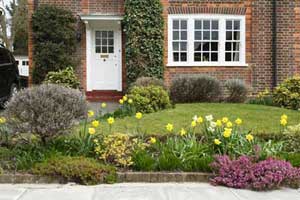
In our first blog of 2022, we consider the matter of the front garden. What is it that buyers expect from a front garden of their prospective home? Is the grassed garden with a front hedge metal gate a thing of the past? Is it really sensible to hard landscape the front garden to enable easy parking? Is the spirit poorer for the lack of greenery and growth? Is there an impact on wildlife? What can owners do to create the very best impression when prospective buyers arrive to view their property?
A front garden with lawn, shrubs, trees and flowers is now an increasingly rare sight. So many dwellings have summarily swept away their traditional front gardens, instead welcoming in the tarmac surfacers and the paving installers. The result? Ungentle, cut-throat hard landscaping, an obsession with gravel, angular lines, the takeover of grey and brown, the occasional garden pot, sometimes a bench. But who wants to sit on a bench looking at block paving, Cotswold chippings or resin bond, with no living hedges or trees to subdue the traffic noise? Call me romantic, but I’d like a soulful bench with an experience, one that is softened and sheltered by the growth and scents of wisteria, periwinkle, lilac or camellia and where I can feel the give of natural growth under my feet.
The rise of the driveway
The rot all started in 1995 under John Major’s government when car ownership was on the rise and planning rules were eased to permit kerb-drops, allowing cars to drive across pavements and park in their front gardens – which then became just ‘fronts’ or ‘blandscapes’. Driven by car ownership and ease of maintenance (no time to mow the lawn; let’s watch Netflix instead), what impact is this having on the kerb appeal of our houses and more importantly on our overall health?
Gardens are our planet
The Royal Horticultural Society reported six years ago (in 2015) that one in four UK front gardens is completely paved over and nearly one in three has no plants. Let’s crank that up significantly, to allow for all those that have been dug up in the interim to accommodate multi-occupier households and more and larger vehicles. We’re all now honed in to the need for sustainability in order to protect the climate, with many of us eating organic whole foods, cutting down our meat consumption, recycling our plastics and buying biodegradable coffee cups. But front gardens – which just haven’t got the same ‘promoting green living’ press – have a big part to play in protecting our planet, too – in Greater London for example gardens (in general) make up a quarter of the land area, so every front garden eaten up by paving contributes to the overall reduction of living, breathing gardens and the increase in hard surfacing.
Environmental issues
There are more immediate practical problems. Hard landscaping brings the risk of floods, because soil absorbs rainwater, but it runs off impermeable surfaces, which puts pressure on drains and sewers and increases the pollution being washed into local rivers. Hard landscaping also creates warmer temperatures because it absorbs and stores daytime heat, increasing the urban heat island effect. Fewer plants also mean there is less carbon dioxide absorbed and less space for insects, small mammals and birds.
Mental health
Green space has a big impact on our physical and mental wellbeing and in pandemic times many of us have found a new sense of appreciation for our gardens and local green spaces. So perhaps we should all ask ourselves whether we should be valuing parking more highly than grass and shrubbery. The irony is that parking on a driveway doesn’t create more street parking because access is needed in front of the property, but it still increases the spread of impermeable surfaces on the local landscape.
There are compromises that can be made and parking can exist harmoniously alongside planting and trees. One device that is used to modify the impact of a hard-landscaped garden is to create wheel tracks with a hard surface and fill in the surrounding area with grass. Add a hedge and some trellis with a climber, and the front garden starts to take shape again.
When thinking about buying and selling, I return to my rural garden bench argument – the front of a house and its approach, whether green or not, is the first judgement you make about a new house. And if smelling the lilac and seeing the butterflies clustering on its blooms makes their hearts beat a bit faster, then you’ve drawn your potential buyers in before they’ve walked over the threshold.


